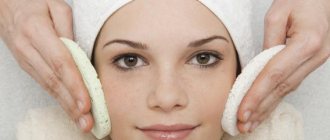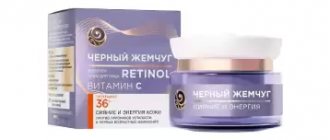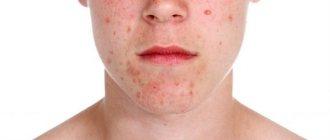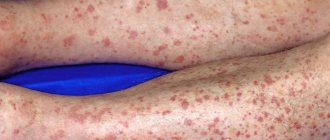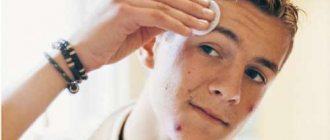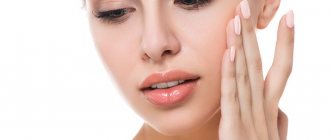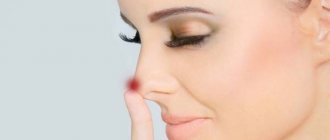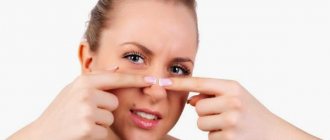What is acne
Acne is a closed inflammation that develops under the surface of the skin. They may look like:
- Papules are painful red bumps.
- Pustules are red bumps with a white abscess on top.
- Nodules are nodular formations that are hard to the touch and look like subcutaneous tubercles.
- Cysts are clusters of nodules.
Where do they come from?
- It all starts with comedones - this is what they call a mixture of dead skin particles, impurities and cosmetic residues that clog the sebaceous ducts.
- Inside the comedon, ideal conditions are created for the development of propionbacteria (they are the ones that provoke inflammation). This is, firstly, the lack of oxygen, and, secondly, the constant replenishment of sebum, which continues to be released and accumulate under the sebaceous plug.
- As a result, bacteria multiply and provoke inflammation - this is how acne appears. They are often called “closed comedones” precisely because all the processes occur below the surface of the skin.
Types of imperfections on the face
In addition to acne, there are other types of inflammation, but all of them are somehow associated with blockage of the sebaceous ducts and/or increased sebum production. What is the difference?
Acne
One pimple is not yet acne. But if they spread all over the face and clump together... This means that we are not talking about a one-time inflammation, but about a serious disease that needs to be treated with the support of specialists - a dermatologist, gynecologist, endocrinologist, cosmetologist and gastroenterologist. If acne is started or treated incorrectly, scars and scars may remain on the skin - post-acne.
Black dots
Blackheads are called “open comedones.” The mechanism of their occurrence is the same as that of acne, but the process occurs not under the skin, but on its surface. By the way, blackheads do not become black because of a large amount of dirt: the reason is the oxidative process that occurs when the sebaceous plug and oxygen interact.
Acne
Essentially, blackheads are blackheads that were not removed in time (we have already mentioned that a mixture of sebum and pollution is an ideal environment for the development of bacteria). If you notice acne on your face, do not peel under any circumstances! During the process of exfoliation, you can spread bacteria all over your face and cause acne.
How is this treated?
Traditional drug treatment includes the use of topical ointments as prescribed by a doctor, along with oral antibiotic therapy or internal medications.
External therapy most often involves the use of retinoid ointments, which reduce inflammation and help exfoliate the top layer of skin. Topical ointments can be used without a prescription. These drugs contain a small amount of active substance and are therefore safe.
In addition to medical attention, it is important to remember that acne develops in moist areas of the skin, so maintaining proper hygiene is important. Timely and thorough cleansing of the skin can significantly reduce inflammatory processes. It is important to give preference to the prescribed care products and not to rub or scratch the wounds, as this will cause additional irritation and worsen the inflammatory process.
You can use drugs with antibacterial action that will help eliminate the inflammatory reaction. You should never squeeze the blackheads because this will spread the bacterial infection and may also cause scarring on the skin.
Extra hydration and protection
Many people make the mistake of thinking that acne-prone skin does not need additional moisturizing. The truth is that adjusting your moisturizing emulsion can help balance sebum production throughout the day. Moisturizing emulsions are easily absorbed, helping to balance moisture levels and prevent aggravation or irritation.
Skin affected by acne needs constant protection from solar radiation, since exposure to direct ultraviolet rays promotes the secretion of sebum. You need to choose sunscreen according to your age and skin type. It is recommended to give preference to products that do not contain parabens.
Nutrition and lifestyle
Lifestyle also influences acne. Diet, stress and hours of sleep also negatively affect the condition of the skin. It used to be that certain foods contributed to acne. Today, a personalized diet is being promoted:
- It is recommended to reduce the consumption of sweet or spicy foods;
- reducing foods that are not beneficial mitigates damage.
In addition to dietary recommendations, you should also use Omega-3 supplements. These are polyunsaturated fatty acids that the body cannot produce on its own, and they are found in sea fish oil or plant products. Their presence will help mitigate inflammatory processes in the body, which means it will have a beneficial effect on all skin diseases and acne in particular.
Causes of acne on the face
Contrary to stereotypes, acne (both small and large) does not only affect teenagers. Nasty lumps can occur in women and men at any age, even infancy! Why does the skin suddenly begin to “bloom”?
Among women
To understand how to get rid of acne, you need to understand what causes the rash. Let's list the main reasons:
- Hormonal disbalance. Hormones can go crazy, for example, during pregnancy or menopause.
- Genetic predisposition. Most often, acne affects those with oily or combination skin types, which are known to be inherited.
- Poor nutrition. “Dangerous trinity” - flour, fatty, sweet. Try removing it from your diet, and your face will become noticeably cleaner!
- Incorrect care. The main stages of caring for problem skin include cleansing, deep cleansing (exfoliation), makeup removal, toning and moisturizing. You can't miss any of them! At the same time, the composition of cosmetics must contain sebum-regulating and bactericidal components: zinc, salicylic acid, eucalyptus or black elderberry extract, activated carbon, clay, etc.
- Digestive problems. A gastrointestinal disorder can lead to an imbalance of intestinal microflora and the accumulation of toxins that negatively affect the condition of the skin.
- Stress. At the most inopportune moment, a pimple popped up in a visible place? The law of meanness has nothing to do with it: it’s just that the stress hormone cortisol also affects sebum production.
- Bad habits. These are, first of all, smoking, alcohol, poor drinking habits and sleepless nights.
In men
- Lack of care or improper care. Due to the large number of sebaceous glands, men's skin almost always suffers from oiliness. Add to this the abundance of testosterone, which stimulates sebum production, and you will have no questions left about where men get acne.
- Shaving. If bacteria get into the wound after shaving, inflammation is not far off.
In children and adolescents
- Hormonal disbalance. During puberty, adolescents begin to undergo global hormonal changes, and the level of testosterone and dihydrotestosterone production increases. And they, in turn, provoke excessive secretion of sebum. Voila, here you have acne! Most often, inflammation in adolescence occurs in the T-zone: this is where most of the sebaceous glands are located.
- Infant acne. The appearance of pimples on the face of infants is associated with imperfections in the excretory system and an excess of maternal hormones. There is no need to treat them: if hygiene standards are observed, they will go away quite quickly on their own.
Causes of formation of papular acne
The problem of papular acne mainly affects young people. In girls, this type of acne is usually more mild.
The changes that appear on the skin during the formation of papular acne are caused by the so-called hormonal storm. At a young age, hormone levels rise rapidly, causing the sebaceous glands to produce more sebum, which does not have time to be removed naturally.
Under physiological conditions, the production of sebum is necessary to create a protective layer on the skin that protects it from external factors. However, its excess, combined with exfoliating epidermis, sweat and dust from the environment, causes clogging of the sebaceous tubules and the appearance of acne, nodules and papules.
Bacteria multiply under the skin, and an inflammatory reaction develops, which is manifested by pain, pinpoint swelling and redness of the facial skin.
Papular acne in adults is caused by excessive stress, inadequate facial care, or problems with hormone (androgen) secretion. The most common problem of adult acne occurs in women, such as during menstruation or pregnancy. Papular changes are accompanied by pimples and acne.
How to properly remove pimples from your face
To remove acne from your face at home, it is important to remember and follow three important beauty rules.
RULE No. 1
Do not squeeze out red inflammation!
First, let the pimple “mature” and draw up a comprehensive plan to destroy the enemy. RULE No. 2
Provide your skin with proper care:
- Cleansing. Look for gels and foams with sebum-regulating and bactericidal components. Makeup remover products should have an oil-free base.
- Deep cleansing. Do not use scrubs during periods of exacerbation. If your skin is often inflamed, try creams with acids that will provide the most gentle exfoliation.
- Toning. Tonic will help wash away any remaining impurities and makeup, cleanse pores and prepare the skin for the next stage of your beauty routine.
- Hydration. If your facial skin is dehydrated, the sebaceous glands begin to secrete even more sebum, so be sure to moisturize your skin. Must have in the composition is hyaluronic acid.
- Additional care. Two or three times a week, pamper your skin with masks with a mattifying effect: for example, based on clay or activated carbon.
RULE No. 3
If acne covers your entire face and has spread to your shoulders and chest, be sure to consult a cosmetologist!
Is it possible to get rid of acne quickly?
What to do if you need to get rid of hated acne as soon as possible? We reveal the most effective methods of care!
How to get rid of acne on your face in a week
A week is enough time to develop a program to combat acne together with a cosmetologist and remove skin imperfections.
- CARE Use home care cosmetics for problematic facial skin. It is less traumatic than, for example, salicylic acid in its pure form. And don't forget about hydration - this is the foundation!
- HYGIENE Wash your face twice a day with gel or foam and dry your face with paper towels. Fabrics can be carriers of bacteria.
- TESTS Get tested for hormones, as well as general and biochemical blood tests. Discuss them with your cosmetologist.
What should you not do if you have an inflamed pimple on your nose*?
If you have inflammatory acne* on the nose and other areas of the face and body, it is strictly forbidden to perform the following actions106:
- Squeeze out rashes. Self-opening of acne* leads to the active spread of infection, a sharp increase in inflammatory rashes, damage to blood vessels, and tissue scarring.
- Washing your face too often. Many people mistakenly assume that frequent washing will help get rid of acne quickly. In fact, such manipulations destroy the natural protective barrier of the skin, lead to pathological activity of the sebaceous glands, and an exponential increase in the number of acne. Two washes a day are enough.
- Use alcohol lotions. Despite the great temptation to dry out a red pimple under your nose with alcohol-containing products, it is better to abandon this idea. Dry skin, chemical burns, pathogenic activity of the sebaceous glands, intensive development of inflammation - these are only a small part of the troubles that result from the frequent use of alcohol products for acne.
- Mask pimples on the nose. Regular use of foundation and powder to cover acne can lead to an increase in the number of breakouts. Makeup is not a contraindication for acne, but frequent use of thick cosmetics can lead to clogged pores.
How to get rid of acne at home using cosmetics
To get rid of acne forever, stock up not only with patience, but also with a decent arsenal of skincare products with sebum-regulating, exfoliating and anti-inflammatory ingredients. The minimum program is a gel or foam cleanser, makeup remover, toner, scrub and face mask.
